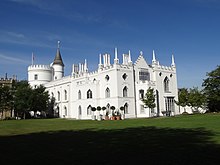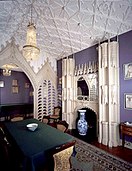Strawberry Hill (structure)

Strawberry Hill is a castle-like country house that the writer and politician Horace Walpole, 4th Earl of Orford , built on the Thames near Twickenham ( London ) between 1749 and 1776 . The building became a model for a large number of similar villas and castles in Europe and gave the impetus for the Gothic Revival (neo-Gothic) called revival of the Gothic architectural style.
Building
In 1748 Horace Walpole bought a small villa on the Thames and was thinking of converting it into his “little gothic castle”. He made a rough sketch that told the architect how he envisioned the neo-Gothic change. From 1749, it was therefore expanded in several construction stages. Walpole founded the “Committee of Taste” with two friends, the architect John Chute and the draftsman Richard Bentley. Bentley left the "Committee" in 1761 after a dispute, as Walpole had meanwhile rigorously rejected its designs. William Robinson (1720–1775) from the Royal Office of Works took care of the professional building supervision. The mantelpiece and bay window in the breakfast room also come from him.
Architectural models were various buildings in England and other countries from the Gothic period. A chapel built under Henry VII in Westminster Abbey provided the model for a ribbed vault above the gallery , but details from tombs in Westminster and Canterbury could also be integrated into the building in a modified form. Walpole used the outer forms of cathedrals inside his house; the outside was a mixture of a castle with battlements and towers and a Gothic church with pointed arched windows.
The first phase of construction began in 1749 and completed in 1753, the second began in 1760. From 1772 to 1776 further changes and additions were made, such as the Beauclerk Tower . This was completed according to the plans of a professional architect, James Essex.
In art history, the year 1776 is usually seen as the dividing line between “gothic survival” and “gothic revival”, ie post-Gothic and neo-Gothic.
Gothic novel
Strawberry Hill was also the model for the novel Das Schloss von Otranto ( The Castle of Otranto ), Walpoles 1764 first published under a pseudonym work, with which he founded the literary genre of the " Gothic Novel ". Since then, the architecture of the setting has played an essential role in every gaudy novel . Stairs, galleries, hidden rooms, vaults and dungeons were associated with this genre, which was very cultivated in the Romantic era . But while Walpole's literature was ultimately still connected to the Enlightenment , the irrational comes to the fore again in later literary works of this genre.
Later owner and present
After Walpole's death, his cousin Anne Seymour Damer inherited Strawberry Hill House. In 1797 it came into the possession of John Waldegrave, a grandson of Maria Walpole , the illegitimate daughter of Walpole's older brother Edward. In the first half of the 19th century, Strawberry Hill had two successive owners, brothers John and George Waldegrave. When they had spent most of the family's fortune, the entire contents of Strawberry Hill House were sold in a twenty-four day auction in 1842. In 1883 the German banker Baron Hermann de Stern (1815–1887) acquired the property. In 1923 Strawberry Hill House came into the possession of St. Mary's University College in Twickenham . Its use as a training center for teachers and students could not prevent the building near the Thames from being threatened by moisture damage and rust. In 2004 Strawberry Hill was on the biennial list of the World Monuments Fund , which lists particularly important but endangered historical monuments. In 2007, the building was leased long-term to the Strawberry Hill Trust, which has set itself the goal of faithfully restoring it. After extensive renovation work, during which all damage was removed and later built-in components, the building can now be viewed again. The gardens were also restored in the spirit of the builder. As the home of Horace Walpole, the castle is also a first-rate literary memorial , comparable to Abbotsford , the castle-like residence of the Scottish writer Walter Scott . In 2013, the Strawberry Hill Trust was awarded the Grand Prix of the Europa Nostra Prize in the Conservation category.
Trivia
In 1966 the "Edgar Wallace" film " The Secret of the White Nun " was shot here.
Individual evidence
- ↑ "THE STERNS AND THE MICHELHAMS" at www.strawberryhillhouse.org.uk
- ↑ Maev Kennedy: Strawberry Hill, Horace Walpole's fantasy castle, to open its doors again. The Guardian on February 25, 2015, accessed February 2, 2018
- ↑ Strawberry Hill . Europa Nostra Awards from March 26, 2013, accessed on February 2, 2018
literature
- Horace Walpole : The Castle of Otranto . Berlin, 1810. Full text at zeno.org
- Edward Jones, Christopher Woodward: A Guide to the Architecture of London. Weidenfeld & Nicolson, London 1983, ISBN 0-297-78188-X .
- Norbert Miller: Strawberry Hill. Horace Walpole and the aesthetics of beautiful irregularities. Carl Hanser, Munich 1986, ISBN 3-446-13124-8 .
- Anna Chalrcraft, Judith Viscardi: Strawberry Hill. Horace Walpole's Gothic Castle. Frances Lincoln, London 2007, ISBN 0-711-22687-3 .
- Michael Snodin (Ed.): Horace Walpole's Strawberry Hill, exhibition catalog Yale Center for British Art 2009. Yale University Press, New Haven / London 2009, ISBN 0-300-12574-7 .
Web links
- Strawberry Hill House and Garden (English)
- Website of the Friends of Strawberry Hill (English)
Coordinates: 51 ° 26 '17 " N , 0 ° 20' 6.5" W.






